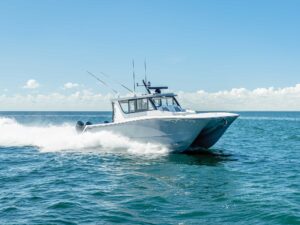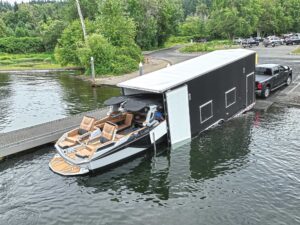There’s a big race to see who can build the best inshore/offshore fishboat, and Scout Boats is challenging this dual-mission competition with its new 240. Thanks to a scant 11″ draft with its motor up, the 240 is a strong player on the flats. Many of its competitors draw 5″ to 6″ more-a problem when you’re chasing reds and snook, which hang out where the “deep” water barely touches your knees. Yet the 240’s 8’6″ beam provides a stable platform when trolling for kingfish and dolphin.
The 240’s most unique feature? The rod stowage that runs along the outer edges of the forward casting deck is completely hidden. Flip-down hatches make it easy to stow rods up to 8’6″ long in any of the four tubes on each side. Rubber cords secure the rods in place. The compartment locks-no one would know that any rods are there. Some larger boats offer similar rodboxes, but you’ll be hard pressed to find them on any other shallow-water fishboat.
The 240 also has a large stowage compartment in the console, with 4’5″ of headroom-enough to accommodate a portable MSD. Another feature aboard the 240 that’s rare on skinny-water machines is a removable settee that spans the stern deck. All compartment lids are foam cored. They’re strong and stiff, but lightweight, and have a nice clean finish. One obvious omission: There’s no hawsepipe for the anchor rode, although there’s a large anchor locker. Just a notch in the hatch would do the trick. Sooner or later you’ll step on the hatch and either damage it or the hinges.
Overall, the fit and finish of the 240 is as good as it gets on a production boat of this price. For example, the cupholders, set flush into the aft deck, have drain tubes that lead water to the scuppers, which is better than having water drip into the bilge. The 90-gallon fuel tank and our test boat’s 200-hp Yamaha HPDI-which delivered 5.0 mpg at 3500 rpm-provide awesome range. Top speed was 46.8 mph with a tower.
Designed as a release well for redfish and snook during tournaments, the livewell is a monster, maybe the largest in its class. It tapes 5’8″ across the beam, 1’2″ fore and aft, and 1’1″ deep. There’s a standard baitwell in the port corner, too. A comparison? With an Evinrude Ficht 200, the Hydra-Sports 22 lists for $32,000. It’s a considerably deeper boat, with 20 degrees of deadrise. Also, it draws 1’2″ at rest, so it’s more appropriate outside the reef.
LAST WORD: Flats or bluewater, fish this boat hard.
LOA………23’10” ** **
Beam…….8’6″ ** **
Draft…….2’3″ ** **
Displacement (lbs., approx.)…..2,400 ** **
Transom deadrise……16° ** **
Bridge clearance……5’5″ ****
Minimum cockpit depth…1’7″
Max. headroom….4’5″
Fuel capacity (gal.)…….90
Price (w/o power)…….$18,565
Price (w/test power)…….$34,544
STANDARD POWER: None.
OPTIONAL POWER: Single outboard to 250 hp.
TEST BOAT POWER: Single 200-hp Yamaha 200 HPDI V-6 outboard with 158.4 cid, 3.54″ bore x 2.68″ stroke, swinging a 15 1/4″ x 19″ three-bladed ss prop through a 1.86:1 reduction.
STANDARD EQUIPMENT (major items): Locking rodboxes; console head compartment; release well; livewell; leaning post w/folding footrest; flush-mount deck hardware; tilt steering.









